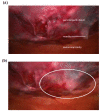Liposome bupivacaine for postsurgical pain in an obese woman with chronic pain undergoing laparoscopic gastrectomy: a case report
- PMID: 24450503
- PMCID: PMC3974146
- DOI: 10.1186/1752-1947-8-21
Liposome bupivacaine for postsurgical pain in an obese woman with chronic pain undergoing laparoscopic gastrectomy: a case report
Abstract
Introduction: To reduce incidence and severity of postsurgical pain and minimize the effect of its clinical and economic correlates, multimodal therapy for surgical patients is recommended. In this report, we discuss the use of liposome bupivacaine, a novel multivesicular formulation of bupivacaine indicated for single-dose infiltration into the surgical site to produce postsurgical analgesia, as part of a multimodal analgesic regimen in a patient with a history of chronic pain scheduled to undergo laparoscopic sleeve gastrectomy. To the best of our knowledge, this is the first published report of liposome bupivacaine in the setting of laparoscopic sleeve gastrectomy.
Case presentation: A 35-year-old white woman with morbid obesity was admitted for laparoscopic sleeve gastrectomy to lose weight prior to hip replacement surgery. Because of a complicated medical history that included rheumatoid arthritis, fibromyalgia, diabetes mellitus, hypertension, and chronic pain, for which she was receiving high doses of opioid analgesics, postsurgical pain management was a concern and she was considered a candidate for multimodal analgesia. At initiation of surgery, 50mL of lidocaine and epinephrine was infiltrated around the port sites. At the conclusion, 25mL of normal sterile saline was added to a 20mL vial of liposome bupivacaine (266mg) and injected around the port sites and at the site of liver retraction. Laparoscopic sleeve gastrectomy was successfully completed. Our patient was discharged to the postanesthesia care unit for approximately four hours before discharge to the surgical floor with a pain score of 5 (11-point scale; 0 = no pain, 10 = worst possible pain). Her postoperative course was uneventful; no adverse events were recorded during surgery or during the remainder of her hospital stay. Our patient was discharged on the same opioid regimen used previously for control of her preexisting chronic pain.
Conclusions: Liposome bupivacaine use in this morbidly obese patient undergoing laparoscopic sleeve gastrectomy provided analgesic efficacy and limited postsurgical opioids to a level comparable with her baseline opioid regimen for chronic pain. Given her complex medical history and previous issues with acute and chronic pain, we consider these results highly successful and continue to use liposome bupivacaine as part of a multimodal analgesic regimen in an effort to optimize postsurgical pain management.
Figures

Similar articles
-
Evolving Role of Local Anesthetics in Managing Postsurgical Analgesia.Clin Ther. 2015 Jun 1;37(6):1354-71. doi: 10.1016/j.clinthera.2015.03.017. Epub 2015 Apr 10. Clin Ther. 2015. PMID: 25866297 Review.
-
Infiltration of liposome bupivacaine into the transversus abdominis plane for postsurgical pain management in a 39-year-old female undergoing laparoscopic cholecystectomy.Pain Med. 2014 Aug;15(8):1312-5. doi: 10.1111/pme.12356. Epub 2014 Jan 21. Pain Med. 2014. PMID: 24612211
-
Liposome Bupivacaine for Postsurgical Analgesia in Adult Patients Undergoing Laparoscopic Colectomy: Results from Prospective Phase IV Sequential Cohort Studies Assessing Health Economic Outcomes.Curr Ther Res Clin Exp. 2013 Dec 27;76:1-6. doi: 10.1016/j.curtheres.2013.12.001. eCollection 2014 Dec. Curr Ther Res Clin Exp. 2013. PMID: 25031661 Free PMC article.
-
Infiltration of liposome bupivacaine into the transversus abdominis plane for postsurgical analgesia in robotic laparoscopic prostatectomy: a pilot study.Local Reg Anesth. 2014 Dec 12;7:69-74. doi: 10.2147/LRA.S64515. eCollection 2014. Local Reg Anesth. 2014. PMID: 25540595 Free PMC article. Review.
-
Extended pain relief trial utilizing infiltration of Exparel(®), a long-acting multivesicular liposome formulation of bupivacaine: a Phase IV health economic trial in adult patients undergoing open colectomy.J Pain Res. 2012;5:567-72. doi: 10.2147/JPR.S38621. Epub 2012 Nov 20. J Pain Res. 2012. PMID: 23204866 Free PMC article.
Cited by
-
Fascial Closure vs. Non-closure of Right Working Port Sites in Laparoscopic Bariatric Surgery: A Randomized Clinical Trial.Obes Surg. 2025 Jul;35(7):2578-2587. doi: 10.1007/s11695-025-07917-2. Epub 2025 May 23. Obes Surg. 2025. PMID: 40407981 Free PMC article. Clinical Trial.
-
Postoperative pain after laparoscopic sleeve gastrectomy: comparison of three analgesic schemes (isolated intravenous analgesia, epidural analgesia associated with intravenous analgesia and port-sites infiltration with bupivacaine associated with intravenous analgesia).Surg Endosc. 2017 Jan;31(1):231-236. doi: 10.1007/s00464-016-4961-3. Epub 2016 May 13. Surg Endosc. 2017. PMID: 27177956 Clinical Trial.
-
Does Preincisional Infiltration with Bupivacaine Reduce Postoperative Pain in Laparoscopic Bariatric Surgery?Obes Surg. 2016 Feb;26(2):282-8. doi: 10.1007/s11695-015-1761-0. Obes Surg. 2016. PMID: 26084250
-
Laparoscopic-Guided Transversus Abdominis Plane (TAP) Block as Part of Multimodal Analgesia in Laparoscopic Roux-en-Y Gastric Bypass Within an Enhanced Recovery After Surgery (ERAS) Program: a Prospective Randomized Clinical Trial.Obes Surg. 2018 Nov;28(11):3374-3379. doi: 10.1007/s11695-018-3376-8. Obes Surg. 2018. PMID: 29980989 Clinical Trial.
References
-
- Wu CL, Naqibuddin M, Rowlingson AJ, Lietman SA, Jermyn RM, Fleisher LA. The effect of pain on health-related quality of life in the immediate postoperative period. Anesth Analg. 2003;97:1078–1085. - PubMed
-
- Exparel [package insert] Parsippany, NJ: Pacira Pharmaceuticals, Inc; 2012.
LinkOut - more resources
Full Text Sources
Other Literature Sources

